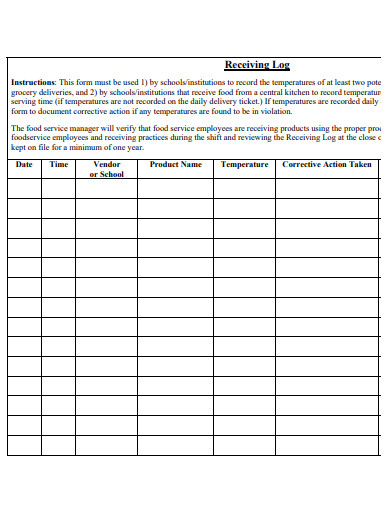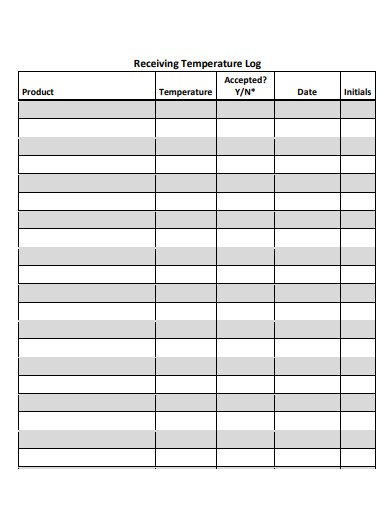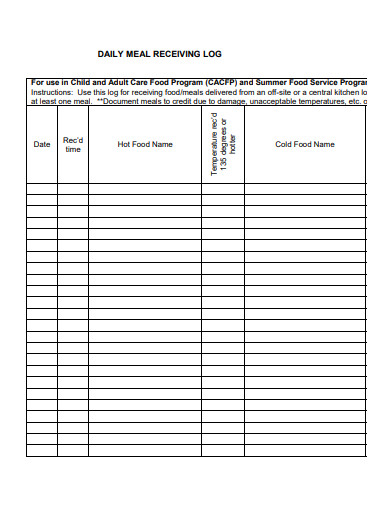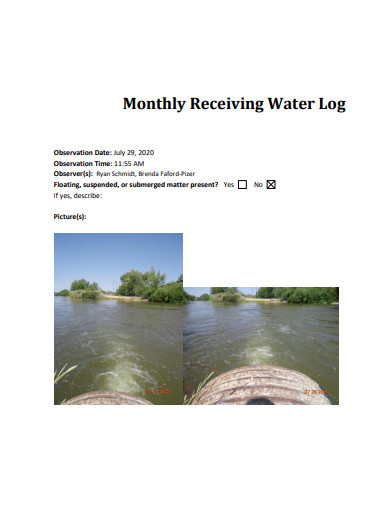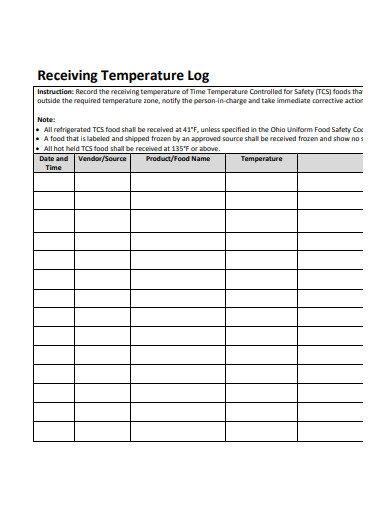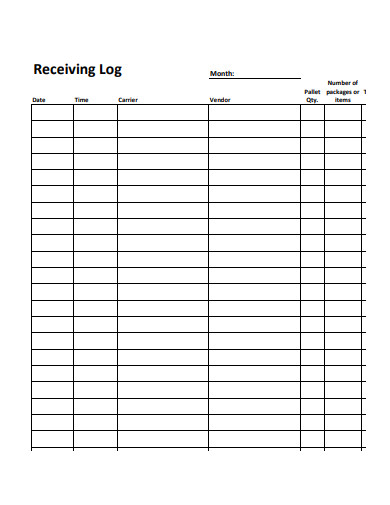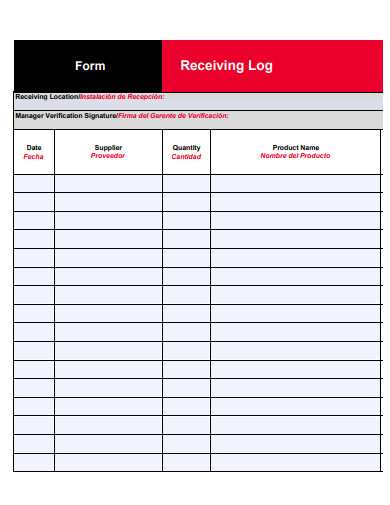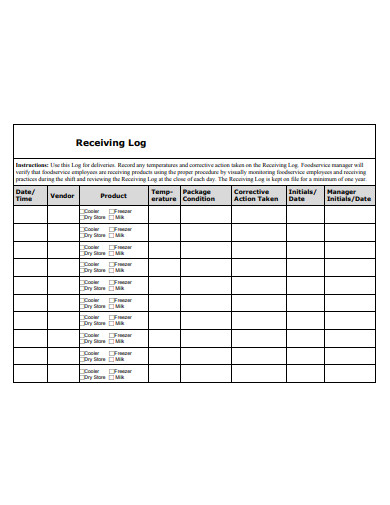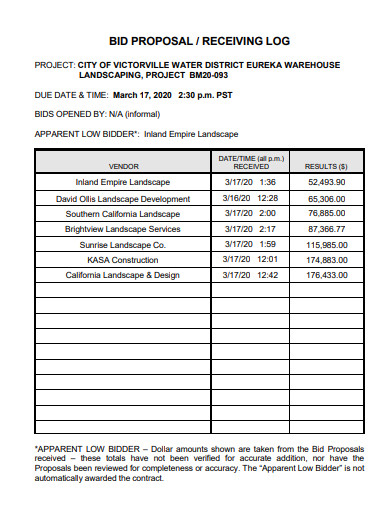10+ Receiving Log Samples
Warehouse and inventory managers frequently utilize receiving logs to track the inflow of commodities. Receiving logs are used to check that everything that was paid for arrived on schedule and in acceptable shape, and that the volume and kind of arriving products match expectations. Not only would using digital receiving logs decrease paper waste, but it would also make communications and record-keeping simpler because all logs would be kept in one location, making work more efficient. Thinking of creating one? You need all the help you can get. Look no further, because we’ve got you covered! In this article, we provide you with free and ready-made samples of Receiving Logs in PDF and DOC format that you could use for your benefit. Keep on reading to find out more!
1. Receiving Log
2. Sample Receiving Log
3. Receiving Temperature Log
4. Daily Meal Receiving Log
5. Monthly Receiving Water Log
6. Sample Receiving Temperature Log
7. Sample Receiving Log
8. Receiving Log Example
9. Formal Receiving Log
10. Professional Receiving Log
11. Printable Receiving Log
What is a receiving log?
A receiving log is a record of what was delivered, when it was delivered, and who got it. A receiving report, also known as a receiving checklist, is often filled out by a company’s receiving crew and then shared with the receiving team, accounting team, and other supervisors. The receiving log can be used as a receipt or documentation of a completed business transaction. Because the record will contain specifics of the products delivered, it may be utilized to assist discover missing items or things that need to be returned. This might waste time and money because employees would be preoccupied with compensating for unanticipated shortages. A receiving log is also used to keep track of inventories.
How to make a receiving log
In certain circumstances, a company’s accounting staff may consult the logs on a regular basis to guarantee that paid products arrive, to compute past and future costs, and to see whether any financial adjustments are necessary to accommodate their suppliers. A Receiving Log Template can help provide you with the framework you need to ensure that you have a well-prepared and robust log on hand. To do so, you can choose one of our excellent templates listed above. If you want to write it yourself, follow these steps below to guide you:
1. Obtain the necessary forms or charts.
Organizations have created or published charts and forms for producing log reports in several cases. If this is the situation in your company, you’ll need those charts to keep track of the logs. Nevertheless, in some cases, you must construct the entire log report on your own. So, if that’s the process, make sure you follow it and then write the report.
2. Without any delays, record the log.
Once the incident has occurred, no time should be wasted documenting the log. Within minutes after the incident, the appropriate time to record the file and create the document is. As a result, get to work on the registration as soon as possible.
3. Make a quick summary.
When writing the report, start with an outline of the incident. This means that the event must be explained. This summary does not require any more explanation. If you’re on a tight schedule, you can also choose to compose just one sentence regarding the case. You must be as succinct as possible while providing the relevant information.
4. Determine the necessary information.
Up most cases, the institution’s log papers have blanks or gaps that must be filled in regarding the occurrence. After that, you may move on to creating the report. If no other options are available, the information must be manually entered into the document. This includes basic event statistics and information such as the date, time, and location, as well as the names of those involved.
FAQ
What are the advantages of a log analysis?
Use Log Analysis to shorten the time it takes to diagnose and resolve problems, allowing you to better manage your infrastructure and applications.
When analyzing logs, what should I check for?
Examine if the time stamps on logs can be trusted; take into account time zone variances. Pay attention to recent changes, failures, problems, status changes, access and administration events, and other out-of-the-ordinary occurrences in your environment.
What is cyber security log?
A log keeps track of what happens in an organization’s systems and networks.
Monitoring and alerting, compliance with security policies, audits and regulatory compliance, security incident response, and even forensic investigations all benefit from logging. To help you get started, download our easily customizable and comprehensive samples of Receiving Logs today!
Related Posts
FREE 25+ Receipt Templates in PDF MS Word | Excel
FREE 7+ Sample Delivery Slips in MS Word PDF
FREE 7+ Sample Financial Declaration Forms in PDF MS Word
FREE 9+ Defendant Information Form Samples in PDF MS Word
FREE 7+ Sample Payment Receipt Forms in PDF
FREE 8+ Sample Bill of Lading Forms in MS Word PDF
FREE 9+ Sample Employee Uniform Forms in MS Word PDF
FREE 10+ Daily Inventory Samples in MS Word Google Docs ...
FREE 28+ Printable Accounting Forms in PDF MS Word
FREE 41+ Sample Receipts in PDF MS Word
FREE 7+ Sample Advance Payment Receipts in MS Word PDF
FREE 10+ Landlord Statement Form Samples in PDF
FREE 33+ Sample Log Templates in PDF MS Word
FREE 15+ Medical Authorization Forms in PDF Word
FREE 9+ Sample Medical Order Forms in MS Word PDF

